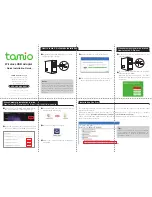
7
Setting the bus addresses
Connecting the programming device
O
Make sure the system part is not under pressure or voltage.
O
Unplug the yellow AS-i cable from the
X7A
connection to disconnect
the bus coupler from the AS bus line.
O
Connect your programming device (see accessories) to the
X7A
socket.
O
Alternatively, perform programming with the PLC via the fieldbus. For more details, refer to
the manuals for your PLC or the controller used.
Activating bus slaves
O
If you have not already done so, loosen the cover screw above DIP switch
S5
on the back side of the product.
O
Before addressing, move only
one
of the four
S5
switches on the back side
of the bus coupler to the
ON
position to activate only one bus slave.
1.3
2/15
12
14
0 V
25
X
X
X
X
X
X
X
X
Table 16:
X2O
pin assignment: variant with 16 outputs
AS-i
OUT
X2O
D-SUB
pin
Valve position
1
2
3
4
5
6
7
8
9
10
11
12
0.0
1
14
0.1
3
14
0.2
5
14
0.3
7
14
1.0
9
14
1.1
11
14
1.2
13
14
1.3
15
14
2.0
16/17
12
14
2.1
14/19
12
14
2.2
12/21
12
14
2.3
10/23
12
14
3.0
8
12
3.1
6
12
3.2
4
12
3.3
2
12
0 V
25
X
X
X
X
X
X
X
X
X
X
X
X
NOTICE
Disconnecting plugs while under voltage will destroy the electronic components of the
valve system!
Large differences in potential occur when disconnecting plugs under voltage, which can
destroy the valve system.
O
Make sure the relevant system component is not under voltage before disconnecting
plugs and/or connecting a programming device.
During addressing, only one bus slave may be activate, i.e. only one DIP switch
S5
may
be in the
ON
position.
Table 15:
X2O
pin assignment: variant with 8 outputs
AS-i OUT
X2O
D-SUB pin
Valve position
1
2
3
4
5
6
7
8
S5
ON
OPEN
Addressing
O
Assign the bus addresses separately, one after another.
O
Assign two valid bus addresses if using the variant with 8 outputs and assign
four valid bus addresses if using the variant with 16 outputs.
Valid addresses
Valid addresses range from 1 to 31.
Invalid addresses
A/B addresses 1 to 62 are invalid.
O
See the following table for bus slave address coding.
O
Activate the bus slave.
O
Position the cover screw on the
S5
switch.
O
Remove the programming cable and connect the AS bus line.
O
Connect the power supply.
Your bus address setting is taken over.
8
Technical data
9
Accessories
Table 17: Positions of the
S5
DIP switch
Bit
OPEN position
ON position
1
Bus slave 0 off
Bus slave 0 on
2
Bus slave 1 off
Bus slave 1 on
3
Bus slave 2 off
Bus slave 2 on
4
Bus slave 3 off
Bus slave 3 on
Table 18: Bus slave address coding
Bus slave
I/O code
ID code
ID2 code
ID1 code
0
7
F
E
F
1
7
F
E
F
2
8
F
E
F
3
8
F
E
F
General
Protection class according to EN 60529/IEC529
IP 65 when assembled
Ambient temperature
ϑ
U
0°C to +50°C, without condensation
Inputs
In accordance with
EN 61131-2, type 3
Electrical data
Operating voltage U
n
on AS-i
26.5 V to 31.6 V DC according
to EN 50295
Max. power consumption from the AS-i network
530 mA
Operating voltage U
n
on AUX
25 V DC (+10%/-10%) protective
extra-low voltage (PELV) according
to IEC 364-4-41, residual ripple 0.5%
Max. current per output channel
100 mA
Max. internal voltage drop per channel
0.7 V
Inputs according to DIN EN 61131-2
8 digital inputs, type 3
Input delay 0-1/1-0
3 ms
Supply power sensors per slave
(4 inputs, 2 M12 sockets)
200 mA
Electromagnetic compatibility
Interference immunity
EN 50295
Interference emission
EN 50295
Accessories
Article number
M12 protective caps for unused inputs
894 135 029 4
AS-i and valve voltage cable socket
894 105 357 2
OPEN
ON
AVENTICS
| AS-i | R412008327–BDL–001–AB | English
7
Summary of Contents for AS-i
Page 9: ......




























